Abstract
Candida species have recently emerged as important nosocomial pathogens. Because of the lack of a reliable system for detecting differences within the same species, little is known about the epidemiology of infection with Candida species. We describe a typing system for Torulopsis glabrata and the non-C. albicans Candida species that uses contour-clamped homogeneous electric field electrophoresis (CHEF), a version of pulsed-field gradient gel electrophoresis, and compared it with restriction enzyme analysis (REA) of genomic DNA. One hundred seventeen clinical isolates from 40 patients were evaluated. CHEF and REA were performed on each of the isolates, and the results of the two procedures were compared. The REA procedure revealed 8 different types of Candida lusitaniae, 20 of Torulopsis glabrata, 5 of Candida tropicalis, 3 of Candida parapsilosis, and 7 of Candida kefyr, whereas the CHEF method revealed 14 different types of C. lusitaniae, 16 of T. glabrata, 10 of C. tropicalis, 10 of C. parapsilosis, and 7 of C. kefyr. The CHEF technique yielded unique patterns of electrophoretic karyotypes that could be used to distinguish intraspecies variations. When compared with REA, CHEF demonstrated greater sensitivity in recognizing subtle strain-to-strain variations in most isolates and will be a useful epidemiologic tool for studying non-C. albicans Candida species and T. glabrata.
Full text
PDF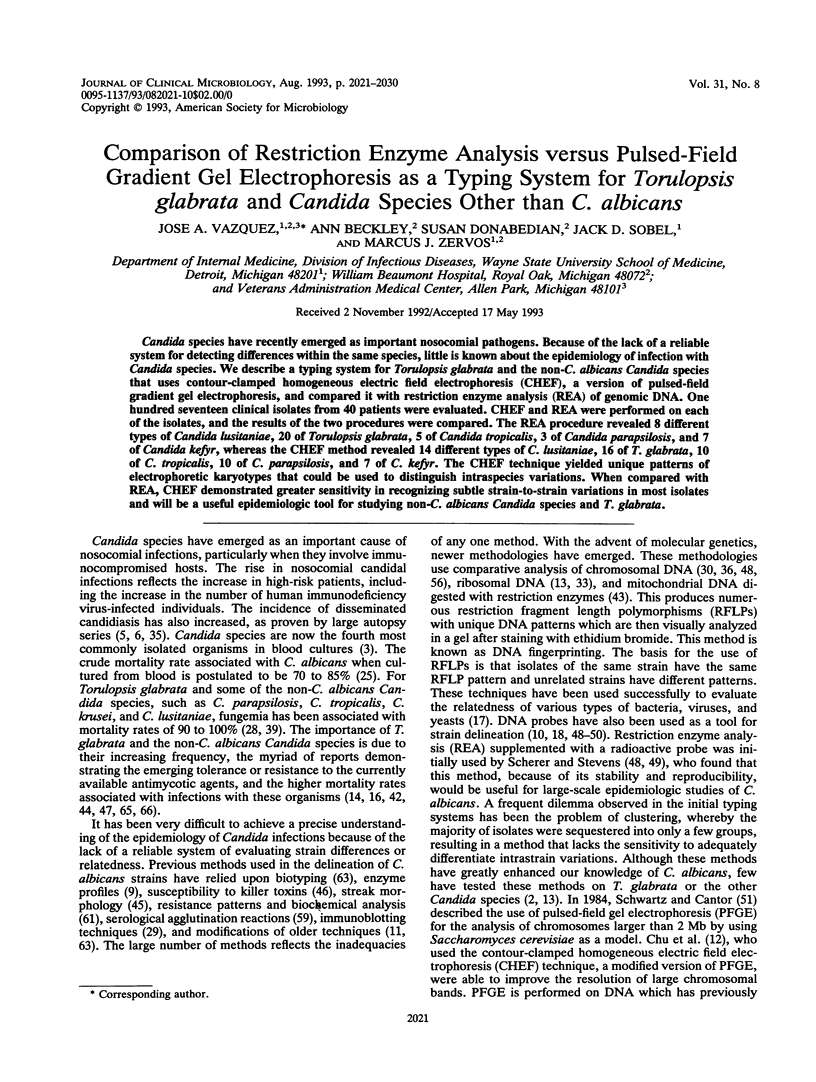
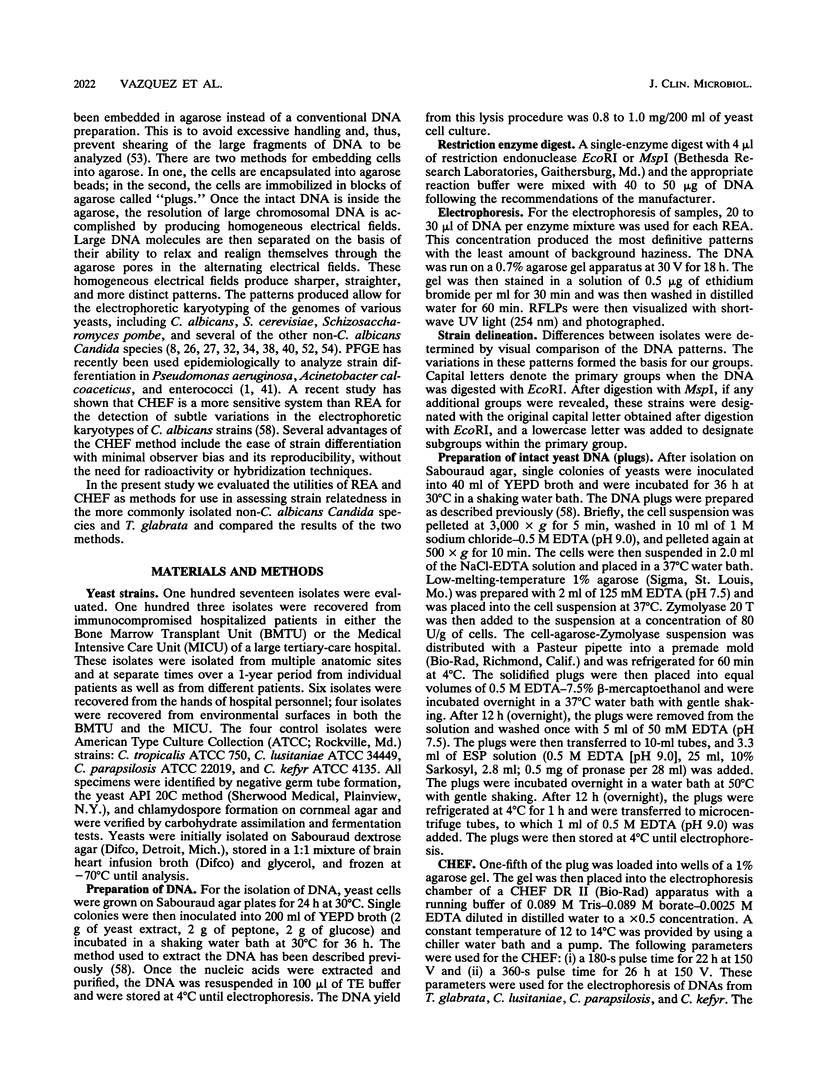
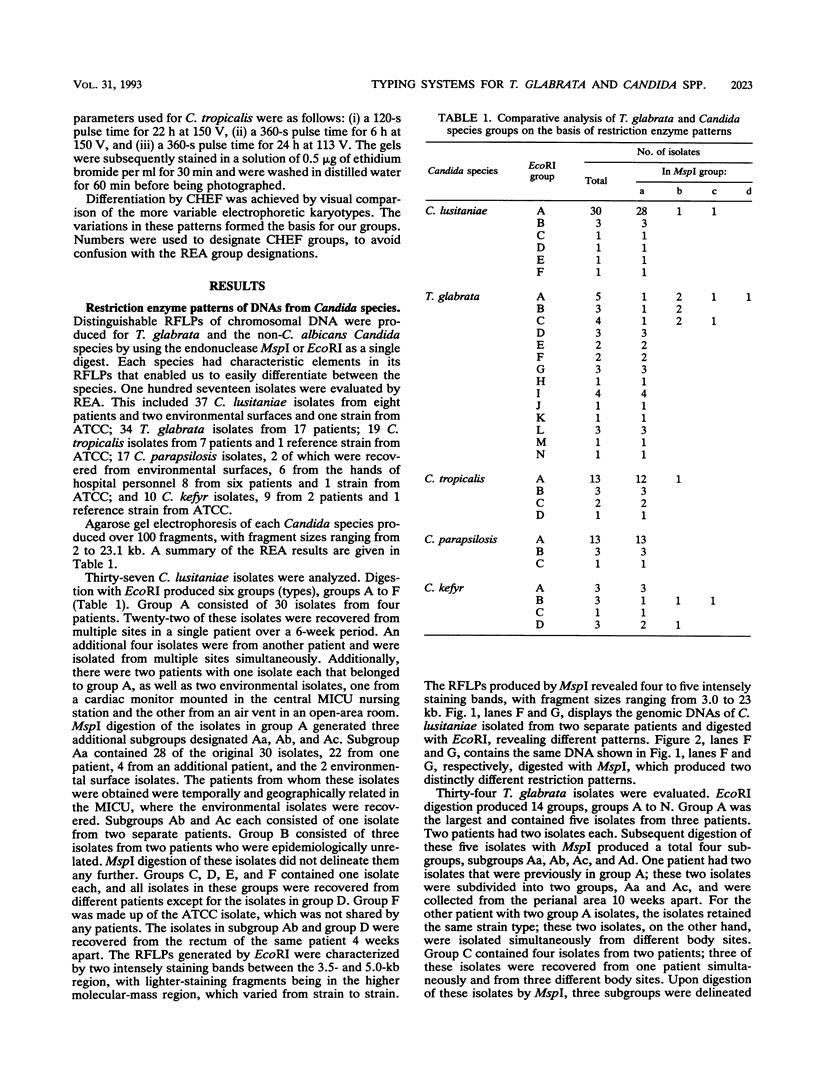

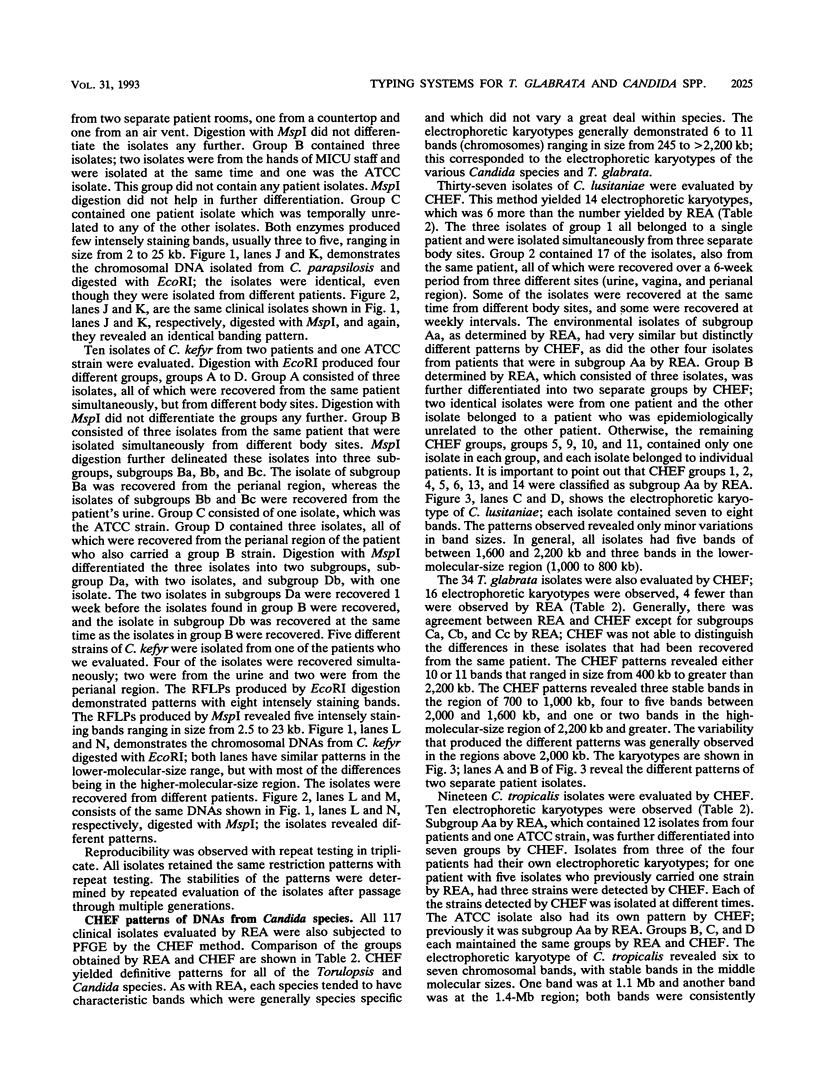
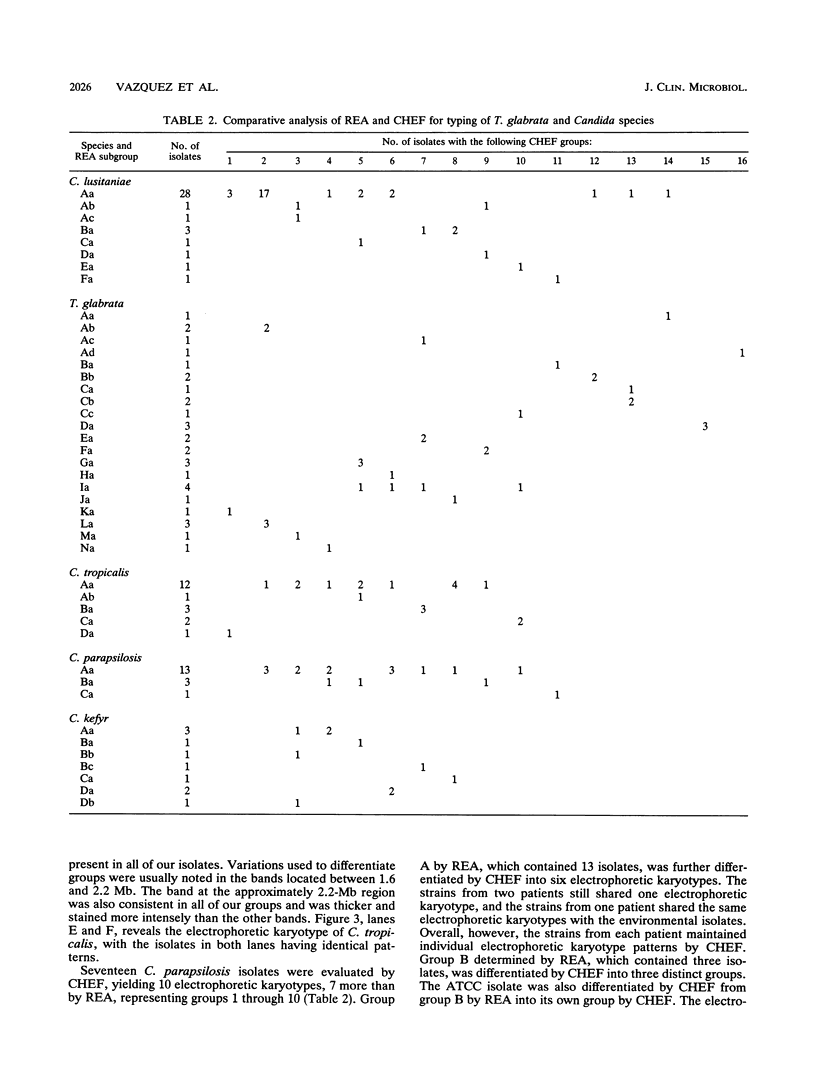

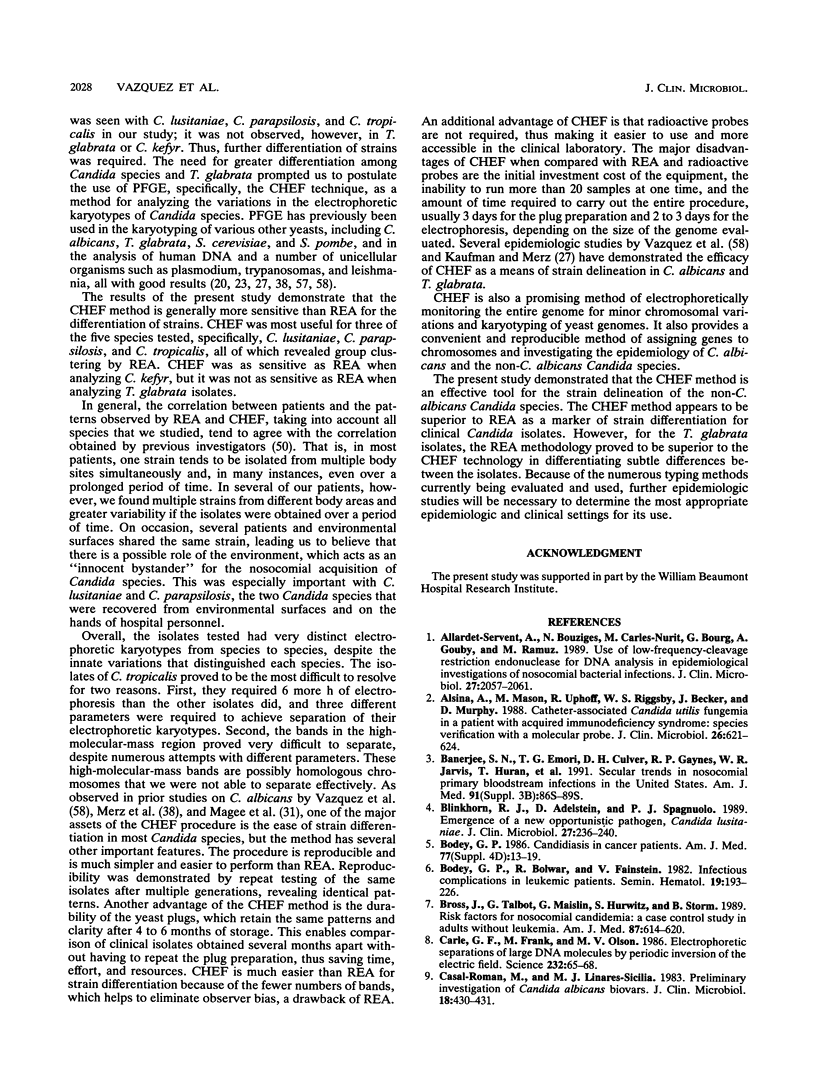
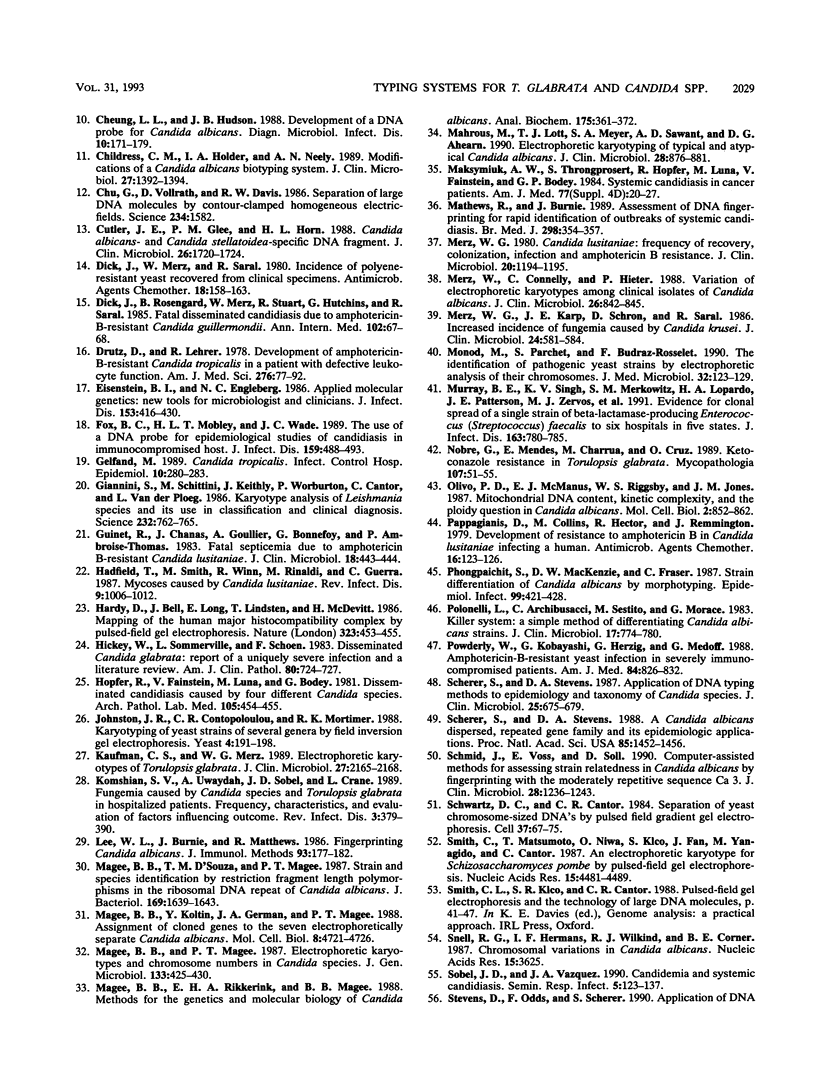

Images in this article
Selected References
These references are in PubMed. This may not be the complete list of references from this article.
- Allardet-Servent A., Bouziges N., Carles-Nurit M. J., Bourg G., Gouby A., Ramuz M. Use of low-frequency-cleavage restriction endonucleases for DNA analysis in epidemiological investigations of nosocomial bacterial infections. J Clin Microbiol. 1989 Sep;27(9):2057–2061. doi: 10.1128/jcm.27.9.2057-2061.1989. [DOI] [PMC free article] [PubMed] [Google Scholar]
- Alsina A., Mason M., Uphoff R. A., Riggsby W. S., Becker J. M., Murphy D. Catheter-associated Candida utilis fungemia in a patient with acquired immunodeficiency syndrome: species verification with a molecular probe. J Clin Microbiol. 1988 Apr;26(4):621–624. doi: 10.1128/jcm.26.4.621-624.1988. [DOI] [PMC free article] [PubMed] [Google Scholar]
- Banerjee S. N., Emori T. G., Culver D. H., Gaynes R. P., Jarvis W. R., Horan T., Edwards J. R., Tolson J., Henderson T., Martone W. J. Secular trends in nosocomial primary bloodstream infections in the United States, 1980-1989. National Nosocomial Infections Surveillance System. Am J Med. 1991 Sep 16;91(3B):86S–89S. doi: 10.1016/0002-9343(91)90349-3. [DOI] [PubMed] [Google Scholar]
- Blinkhorn R. J., Adelstein D., Spagnuolo P. J. Emergence of a new opportunistic pathogen, Candida lusitaniae. J Clin Microbiol. 1989 Feb;27(2):236–240. doi: 10.1128/jcm.27.2.236-240.1989. [DOI] [PMC free article] [PubMed] [Google Scholar]
- Bodey G. P., Bolivar R., Fainstein V. Infectious complications in leukemic patients. Semin Hematol. 1982 Jul;19(3):193–226. [PubMed] [Google Scholar]
- Bodey G. P. Candidiasis in cancer patients. Am J Med. 1984 Oct 30;77(4D):13–19. [PubMed] [Google Scholar]
- Bross J., Talbot G. H., Maislin G., Hurwitz S., Strom B. L. Risk factors for nosocomial candidemia: a case-control study in adults without leukemia. Am J Med. 1989 Dec;87(6):614–620. doi: 10.1016/s0002-9343(89)80392-4. [DOI] [PubMed] [Google Scholar]
- Carle G. F., Frank M., Olson M. V. Electrophoretic separations of large DNA molecules by periodic inversion of the electric field. Science. 1986 Apr 4;232(4746):65–68. doi: 10.1126/science.3952500. [DOI] [PubMed] [Google Scholar]
- Cheung L. L., Hudson J. B. Development of DNA probes for Candida albicans. Diagn Microbiol Infect Dis. 1988 Jul;10(3):171–179. doi: 10.1016/0732-8893(88)90037-5. [DOI] [PubMed] [Google Scholar]
- Childress C. M., Holder I. A., Neely A. N. Modifications of a Candida albicans biotyping system. J Clin Microbiol. 1989 Jun;27(6):1392–1394. doi: 10.1128/jcm.27.6.1392-1394.1989. [DOI] [PMC free article] [PubMed] [Google Scholar]
- Chu G., Vollrath D., Davis R. W. Separation of large DNA molecules by contour-clamped homogeneous electric fields. Science. 1986 Dec 19;234(4783):1582–1585. doi: 10.1126/science.3538420. [DOI] [PubMed] [Google Scholar]
- Cutler J. E., Glee P. M., Horn H. L. Candida albicans- and Candida stellatoidea-specific DNA fragment. J Clin Microbiol. 1988 Sep;26(9):1720–1724. doi: 10.1128/jcm.26.9.1720-1724.1988. [DOI] [PMC free article] [PubMed] [Google Scholar]
- Dick J. D., Merz W. G., Saral R. Incidence of polyene-resistant yeasts recovered from clinical specimens. Antimicrob Agents Chemother. 1980 Jul;18(1):158–163. doi: 10.1128/aac.18.1.158. [DOI] [PMC free article] [PubMed] [Google Scholar]
- Dick J. D., Rosengard B. R., Merz W. G., Stuart R. K., Hutchins G. M., Saral R. Fatal disseminated candidiasis due to amphotericin-B-resistant Candida guilliermondii. Ann Intern Med. 1985 Jan;102(1):67–68. doi: 10.7326/0003-4819-102-1-67. [DOI] [PubMed] [Google Scholar]
- Drutz D. J., Lehrer R. I. Development of amphotericin B-resistant Candida tropicalis in a patient with defective leukocyte function. Am J Med Sci. 1978 Jul-Aug;276(1):77–92. [PubMed] [Google Scholar]
- Eisenstein B. I., Engleberg N. C. Applied molecular genetics: new tools for microbiologists and clinicians. J Infect Dis. 1986 Mar;153(3):416–430. doi: 10.1093/infdis/153.3.416. [DOI] [PubMed] [Google Scholar]
- Fox B. C., Mobley H. L., Wade J. C. The use of a DNA probe for epidemiological studies of candidiasis in immunocompromised hosts. J Infect Dis. 1989 Mar;159(3):488–494. doi: 10.1093/infdis/159.3.488. [DOI] [PubMed] [Google Scholar]
- Gelfand M. S. Candida tropicalis. Infect Control Hosp Epidemiol. 1989 Jun;10(6):280–283. doi: 10.1086/646024. [DOI] [PubMed] [Google Scholar]
- Giannini S. H., Schittini M., Keithly J. S., Warburton P. W., Cantor C. R., Van der Ploeg L. H. Karyotype analysis of Leishmania species and its use in classification and clinical diagnosis. Science. 1986 May 9;232(4751):762–765. doi: 10.1126/science.3961502. [DOI] [PubMed] [Google Scholar]
- Guinet R., Chanas J., Goullier A., Bonnefoy G., Ambroise-Thomas P. Fatal septicemia due to amphotericin B-resistant Candida lusitaniae. J Clin Microbiol. 1983 Aug;18(2):443–444. doi: 10.1128/jcm.18.2.443-444.1983. [DOI] [PMC free article] [PubMed] [Google Scholar]
- Hadfield T. L., Smith M. B., Winn R. E., Rinaldi M. G., Guerra C. Mycoses caused by Candida lusitaniae. Rev Infect Dis. 1987 Sep-Oct;9(5):1006–1012. doi: 10.1093/clinids/9.5.1006. [DOI] [PubMed] [Google Scholar]
- Hardy D. A., Bell J. I., Long E. O., Lindsten T., McDevitt H. O. Mapping of the class II region of the human major histocompatibility complex by pulsed-field gel electrophoresis. Nature. 1986 Oct 2;323(6087):453–455. doi: 10.1038/323453a0. [DOI] [PubMed] [Google Scholar]
- Hickey W. F., Sommerville L. H., Schoen F. J. Disseminated Candida glabrata: report of a uniquely severe infection and a literature review. Am J Clin Pathol. 1983 Nov;80(5):724–727. doi: 10.1093/ajcp/80.5.724. [DOI] [PubMed] [Google Scholar]
- Hopfer R. L., Fainstein V., Luna M. P., Bodey G. P. Disseminated candidiasis caused by four different Candida species. Arch Pathol Lab Med. 1981 Sep;105(9):454–455. [PubMed] [Google Scholar]
- Johnston J. R., Contopoulou C. R., Mortimer R. K. Karyotyping of yeast strains of several genera by field inversion gel electrophoresis. Yeast. 1988 Sep;4(3):191–198. doi: 10.1002/yea.320040304. [DOI] [PubMed] [Google Scholar]
- Kaufmann C. S., Merz W. G. Electrophoretic karyotypes of Torulopsis glabrata. J Clin Microbiol. 1989 Oct;27(10):2165–2168. doi: 10.1128/jcm.27.10.2165-2168.1989. [DOI] [PMC free article] [PubMed] [Google Scholar]
- Komshian S. V., Uwaydah A. K., Sobel J. D., Crane L. R. Fungemia caused by Candida species and Torulopsis glabrata in the hospitalized patient: frequency, characteristics, and evaluation of factors influencing outcome. Rev Infect Dis. 1989 May-Jun;11(3):379–390. doi: 10.1093/clinids/11.3.379. [DOI] [PubMed] [Google Scholar]
- Lee W., Burnie J., Matthews R. Fingerprinting Candida albicans. J Immunol Methods. 1986 Nov 6;93(2):177–182. doi: 10.1016/0022-1759(86)90186-9. [DOI] [PubMed] [Google Scholar]
- Magee B. B., D'Souza T. M., Magee P. T. Strain and species identification by restriction fragment length polymorphisms in the ribosomal DNA repeat of Candida species. J Bacteriol. 1987 Apr;169(4):1639–1643. doi: 10.1128/jb.169.4.1639-1643.1987. [DOI] [PMC free article] [PubMed] [Google Scholar]
- Magee B. B., Koltin Y., Gorman J. A., Magee P. T. Assignment of cloned genes to the seven electrophoretically separated Candida albicans chromosomes. Mol Cell Biol. 1988 Nov;8(11):4721–4726. doi: 10.1128/mcb.8.11.4721. [DOI] [PMC free article] [PubMed] [Google Scholar]
- Magee B. B., Magee P. T. Electrophoretic karyotypes and chromosome numbers in Candida species. J Gen Microbiol. 1987 Feb;133(2):425–430. doi: 10.1099/00221287-133-2-425. [DOI] [PubMed] [Google Scholar]
- Magee P. T., Rikkerink E. H., Magee B. B. Methods for the genetics and molecular biology of Candida albicans. Anal Biochem. 1988 Dec;175(2):361–372. doi: 10.1016/0003-2697(88)90559-3. [DOI] [PubMed] [Google Scholar]
- Mahrous M., Lott T. J., Meyer S. A., Sawant A. D., Ahearn D. G. Electrophoretic karyotyping of typical and atypical Candida albicans. J Clin Microbiol. 1990 May;28(5):876–881. doi: 10.1128/jcm.28.5.876-881.1990. [DOI] [PMC free article] [PubMed] [Google Scholar]
- Maksymiuk A. W., Thongprasert S., Hopfer R., Luna M., Fainstein V., Bodey G. P. Systemic candidiasis in cancer patients. Am J Med. 1984 Oct 30;77(4D):20–27. [PubMed] [Google Scholar]
- Matthews R., Burnie J. Assessment of DNA fingerprinting for rapid identification of outbreaks of systemic candidiasis. BMJ. 1989 Feb 11;298(6670):354–357. doi: 10.1136/bmj.298.6670.354. [DOI] [PMC free article] [PubMed] [Google Scholar]
- Merz W. G., Connelly C., Hieter P. Variation of electrophoretic karyotypes among clinical isolates of Candida albicans. J Clin Microbiol. 1988 May;26(5):842–845. doi: 10.1128/jcm.26.5.842-845.1988. [DOI] [PMC free article] [PubMed] [Google Scholar]
- Merz W. G., Karp J. E., Schron D., Saral R. Increased incidence of fungemia caused by Candida krusei. J Clin Microbiol. 1986 Oct;24(4):581–584. doi: 10.1128/jcm.24.4.581-584.1986. [DOI] [PMC free article] [PubMed] [Google Scholar]
- Monod M., Porchet S., Baudraz-Rosselet F., Frenk E. The identification of pathogenic yeast strains by electrophoretic analysis of their chromosomes. J Med Microbiol. 1990 Jun;32(2):123–129. doi: 10.1099/00222615-32-2-123. [DOI] [PubMed] [Google Scholar]
- Murray B. E., Singh K. V., Markowitz S. M., Lopardo H. A., Patterson J. E., Zervos M. J., Rubeglio E., Eliopoulos G. M., Rice L. B., Goldstein F. W. Evidence for clonal spread of a single strain of beta-lactamase-producing Enterococcus (Streptococcus) faecalis to six hospitals in five states. J Infect Dis. 1991 Apr;163(4):780–785. doi: 10.1093/infdis/163.4.780. [DOI] [PubMed] [Google Scholar]
- Nobre G., Mendes E., Charrua M. J., Cruz O. Ketoconazole resistance in Torulopsis glabrata. Mycopathologia. 1989 Jul;107(1):51–55. doi: 10.1007/BF00437589. [DOI] [PubMed] [Google Scholar]
- Pappagianis D., Collins M. S., Hector R., Remington J. Development of resistance to amphotericin B in Candida lusitaniae infecting a human. Antimicrob Agents Chemother. 1979 Aug;16(2):123–126. doi: 10.1128/aac.16.2.123. [DOI] [PMC free article] [PubMed] [Google Scholar]
- Phongpaichit S., Mackenzie D. W., Fraser C. Strain differentiation of Candida albicans by morphotyping. Epidemiol Infect. 1987 Oct;99(2):421–428. doi: 10.1017/s0950268800067911. [DOI] [PMC free article] [PubMed] [Google Scholar]
- Polonelli L., Archibusacci C., Sestito M., Morace G. Killer system: a simple method for differentiating Candida albicans strains. J Clin Microbiol. 1983 May;17(5):774–780. doi: 10.1128/jcm.17.5.774-780.1983. [DOI] [PMC free article] [PubMed] [Google Scholar]
- Powderly W. G., Kobayashi G. S., Herzig G. P., Medoff G. Amphotericin B-resistant yeast infection in severely immunocompromised patients. Am J Med. 1988 May;84(5):826–832. doi: 10.1016/0002-9343(88)90059-9. [DOI] [PubMed] [Google Scholar]
- Román M. C., Linares Sicilia M. J. Preliminary investigation of Candida albicans biovars. J Clin Microbiol. 1983 Aug;18(2):430–431. doi: 10.1128/jcm.18.2.430-431.1983. [DOI] [PMC free article] [PubMed] [Google Scholar]
- Scherer S., Stevens D. A. A Candida albicans dispersed, repeated gene family and its epidemiologic applications. Proc Natl Acad Sci U S A. 1988 Mar;85(5):1452–1456. doi: 10.1073/pnas.85.5.1452. [DOI] [PMC free article] [PubMed] [Google Scholar]
- Scherer S., Stevens D. A. Application of DNA typing methods to epidemiology and taxonomy of Candida species. J Clin Microbiol. 1987 Apr;25(4):675–679. doi: 10.1128/jcm.25.4.675-679.1987. [DOI] [PMC free article] [PubMed] [Google Scholar]
- Schmid J., Voss E., Soll D. R. Computer-assisted methods for assessing strain relatedness in Candida albicans by fingerprinting with the moderately repetitive sequence Ca3. J Clin Microbiol. 1990 Jun;28(6):1236–1243. doi: 10.1128/jcm.28.6.1236-1243.1990. [DOI] [PMC free article] [PubMed] [Google Scholar]
- Schwartz D. C., Cantor C. R. Separation of yeast chromosome-sized DNAs by pulsed field gradient gel electrophoresis. Cell. 1984 May;37(1):67–75. doi: 10.1016/0092-8674(84)90301-5. [DOI] [PubMed] [Google Scholar]
- Smith C. L., Matsumoto T., Niwa O., Klco S., Fan J. B., Yanagida M., Cantor C. R. An electrophoretic karyotype for Schizosaccharomyces pombe by pulsed field gel electrophoresis. Nucleic Acids Res. 1987 Jun 11;15(11):4481–4489. doi: 10.1093/nar/15.11.4481. [DOI] [PMC free article] [PubMed] [Google Scholar]
- Snell R. G., Hermans I. F., Wilkins R. J., Corner B. E. Chromosomal variations in Candida albicans. Nucleic Acids Res. 1987 Apr 24;15(8):3625–3625. doi: 10.1093/nar/15.8.3625. [DOI] [PMC free article] [PubMed] [Google Scholar]
- Sobel J. D., Vazquez J. Candidemia and systemic candidiasis. Semin Respir Infect. 1990 Jun;5(2):123–137. [PubMed] [Google Scholar]
- Van der Ploeg L. H., Smits M., Ponnudurai T., Vermeulen A., Meuwissen J. H., Langsley G. Chromosome-sized DNA molecules of Plasmodium falciparum. Science. 1985 Aug 16;229(4714):658–661. doi: 10.1126/science.3895435. [DOI] [PubMed] [Google Scholar]
- Vazquez J. A., Beckley A., Sobel J. D., Zervos M. J. Comparison of restriction enzyme analysis and pulsed-field gradient gel electrophoresis as typing systems for Candida albicans. J Clin Microbiol. 1991 May;29(5):962–967. doi: 10.1128/jcm.29.5.962-967.1991. [DOI] [PMC free article] [PubMed] [Google Scholar]
- Warnock D. W., Burke J., Cope N. J., Johnson E. M., von Fraunhofer N. A., Williams E. W. Fluconazole resistance in Candida glabrata. Lancet. 1988 Dec 3;2(8623):1310–1310. doi: 10.1016/s0140-6736(88)92919-4. [DOI] [PubMed] [Google Scholar]
- Warnock D. W., Speller D. C., Day J. K., Farrell A. J. Resistogram method for differentiation of strains of Candida albicans. J Appl Bacteriol. 1979 Jun;46(3):571–578. doi: 10.1111/j.1365-2672.1979.tb00857.x. [DOI] [PubMed] [Google Scholar]
- Warnock D. W. Typing of Candida albicans. J Hosp Infect. 1984 Sep;5(3):244–252. doi: 10.1016/0195-6701(84)90073-2. [DOI] [PubMed] [Google Scholar]
- Wey S. B., Mori M., Pfaller M. A., Woolson R. F., Wenzel R. P. Hospital-acquired candidemia. The attributable mortality and excess length of stay. Arch Intern Med. 1988 Dec;148(12):2642–2645. doi: 10.1001/archinte.148.12.2642. [DOI] [PubMed] [Google Scholar]
- Williamson M. I., Samaranayake L. P., MacFarlane T. W. A new simple method for biotyping Candida albicans. Microbios. 1987;51(208-209):159–167. [PubMed] [Google Scholar]
- Wingard J. R., Merz W. G., Rinaldi M. G., Johnson T. R., Karp J. E., Saral R. Increase in Candida krusei infection among patients with bone marrow transplantation and neutropenia treated prophylactically with fluconazole. N Engl J Med. 1991 Oct 31;325(18):1274–1277. doi: 10.1056/NEJM199110313251803. [DOI] [PubMed] [Google Scholar]
- Wingard J. R., Merz W. G., Saral R. Candida tropicalis: a major pathogen in immunocompromised patients. Ann Intern Med. 1979 Oct;91(4):539–543. doi: 10.7326/0003-4819-91-4-539. [DOI] [PubMed] [Google Scholar]
- Woods R. A., Bard M., Jackson I. E., Drutz D. J. Resistance to polyene antibiotics and correlated sterol changes in two isolates of Candida tropicalis from a patient with an amphotericin B-resistant funguria. J Infect Dis. 1974 Jan;129(1):53–58. doi: 10.1093/infdis/129.1.53. [DOI] [PubMed] [Google Scholar]





